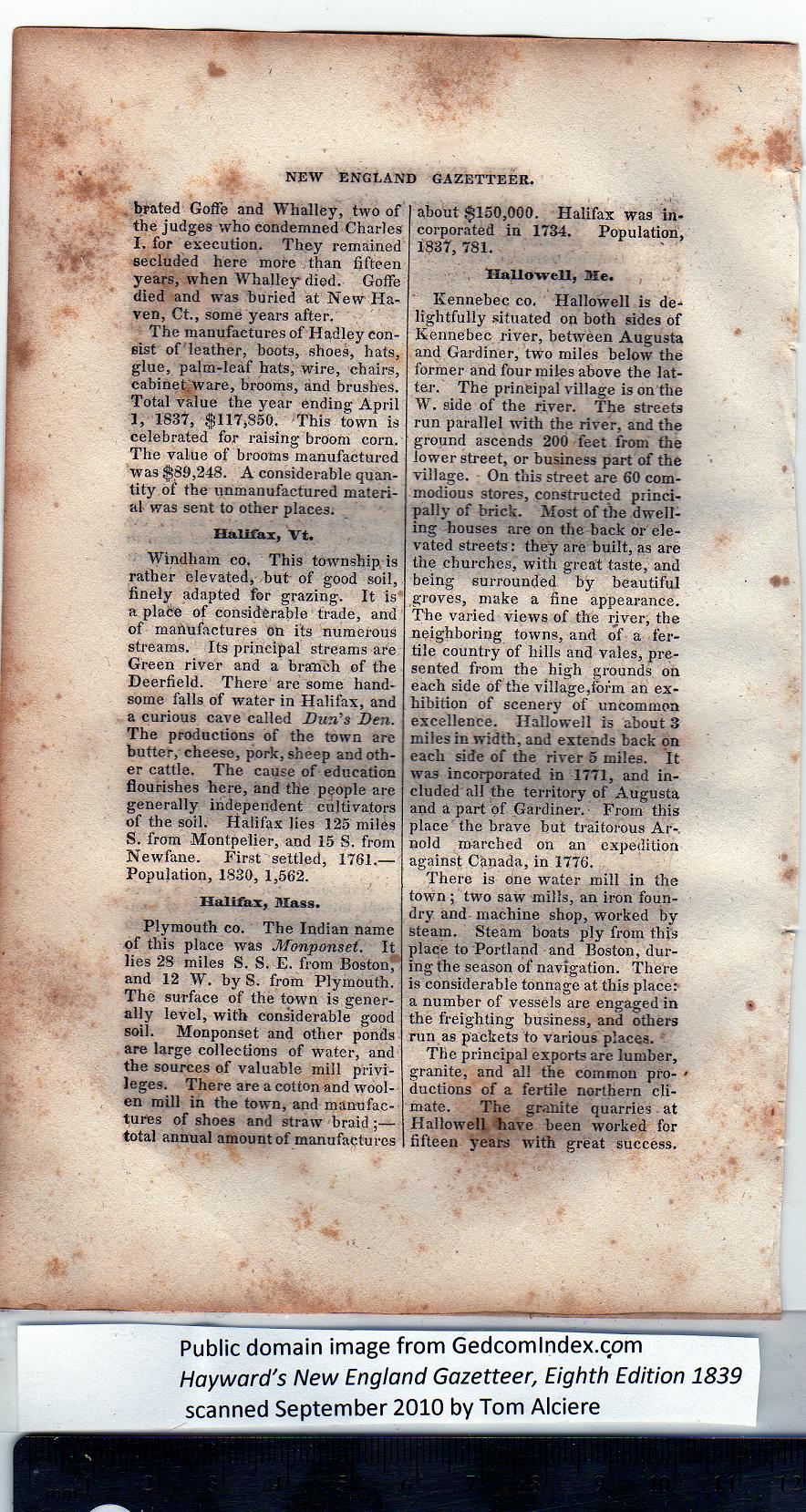|
brated GofFe and Whalley, two of
the judges who condemned Charles
I. for execution. They remained
secluded here more than fifteen
years, when Whalley* died. GofFe
died and was buried at New Ha-
ven, Ct., some years after.
The manufactures of Hadley con-
sist of leather, boots, shoes, hats,
glue, palm-leaf hats, wire, chairs,
cabinet ware, brooms, and brushes.
Total value the year ending April
1, 1837, $117,850. This town is
celebrated for raising broom corn.
The value of brooms manufactured
was $89,248. A considerable quan-
tity of the unmanufactured materi-
al was sent to other places.
Halifax, Vt.
Windham co. This township is
rather elevated, but of good soil,
finely adapted for grazing. It is*
a place of considerable trade, and
of manufactures on its numerous
streams. Its principal streams are
Green river and a branch of the
Deerfield. There are some hand-
some falls of water in Halifax, and
a curious cave called Dun’s Den.
The productions of the town are
butter, cheese, pork, sheep and oth-
er cattle. The cause of education
flourishes here, and the people are
generally independent cultivators
of the soil. Halifax lies 325 miles
S. from Montpelier, and 15 S. from
Newfane. First settled, 1761.—
Population, 1830, 1,562.
Halifax, Mass.
Plymouth co. The Indian name
of this place was Monponset. It
lies 28 miles S. S. E. from Boston,
and 12 W. by S. from Plymouth.
The surface of the town is gener-
ally level, with considerable good
soil. Monponset and other ponds
are large collections of water, and
the sources of valuable mill privi-
leges. There are a cotton and wool-
en mill in the town, and manufac-
tures of shoes and straw braid ;—
total annual amount of manufactures
about $150,000. Halifax was in-
corporated in 1734. Population,
1837, 781. |
Hallowell, lie.
Kennebec co. Hallowell is de-
lightfully situated on both sides of
Kennebec river, between Augusta
and Gardiner, two miles below the
former and four miles above the lat-
ter. The principal village is on the
W. side of the river. The streets
run parallel with the river, and the
ground ascends 200 feet from the
lower street, or business part of the
village. On this street are 60 com-
modious stores, constructed princi-
pally of brick. Most of the dwell-
ing houses are on the back or ele-
vated streets: they are built, as are
tbe churches, with great taste, and
being surrounded by beautiful
groves, make a fine appearance.
The varied views of the river, the
neighboring towns, and of a fer-
tile country of hills and vales, pre-
sented from the high grounds on
each side of the village,form an ex-
hibition of scenery of uncommon
excellence. Hallowell is about 3
miles in width, and extends back pn
each side of the river 5 miles. It
was incorporated in 1771, and in-
cluded all the territory of Augusta
and a part of Gardiner. From this
place the brave hut traitorous Ar-
nold marched on an expedition
against Canada, in 1770.
There is one water mill in the
town; two saw mills, an iron foun-
dry and machine shop, worked by
steam. Steam boats ply from this
place to Portland and Boston, dur-
ing the season of navigation. There
is considerable tonnage at this place:
a number of vessels are engaged in
the freighting business, and others
run as packets to various places.
Tbe principal exports are lumber,
granite, and all the common pro-
ductions of a fertile northern cli-
mate. The granite quarries at
Hallowell iiave been worked for
fifteen years with great success. |
